Update: I also have a soy-free corn-free version of my homemade whole grain chicken feed! For easy formulating, download Garden Betty’s Chicken Feed Calculator to manage costs, calculate protein content, and custom mix your feed on the fly.
More than nine years ago, I started mixing my own soy-free, mostly organic, whole grain chicken feed, and it’s still the best feed I could possibly give my hens. (I’ve tried the entire lineup from the feed store.)
The decision to feed a whole grain diet—versus a commercially formulated diet—is a personal one based on what I believe is best for my hens. Luckily, it also turned out to be an economical decision and a benefit to my own diet.
Homemade chicken feed is not as expensive or complicated as you may have thought or been told.
My small flock of hens lays two dozen eggs a week on a DIY diet of whole grains and leafy greens. Their feathers are soft and shiny, their personalities as perky as ever… so I must be doing something right!
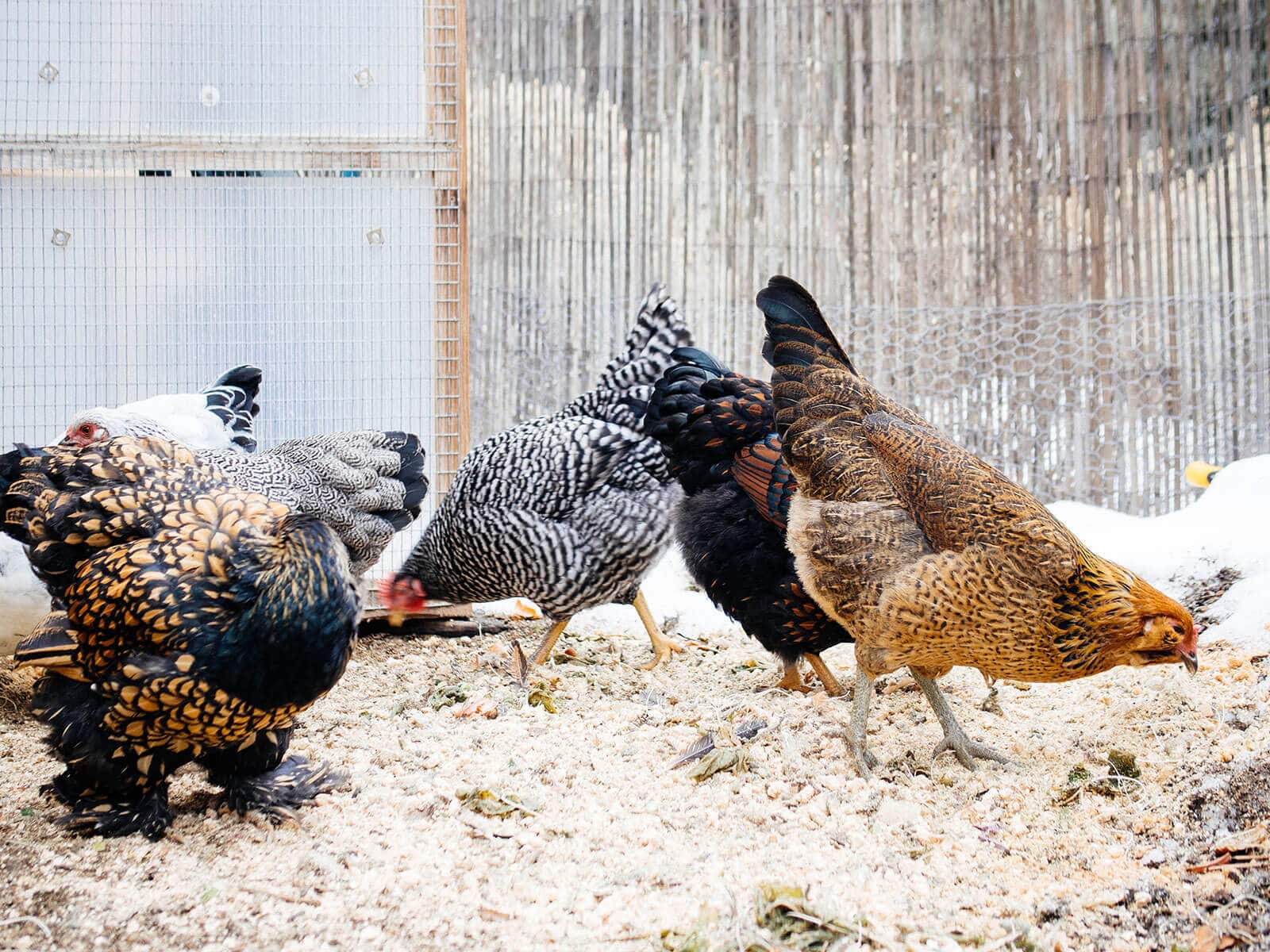
Why should you make your own whole grain chicken feed?
Commercial poultry feed comes in crumble or pellet form, neither of which looks like real food to me. Since real food comes out of my chickens, I want real food to go into them.
Crumbles and pellets are already formulated to contain the nutritional balance that a chicken needs, but the process of cracking, mashing, pressing and/or heating the grains (often times, not even quality grains) causes them to go stale and lose some of their nutritional value—even months before you buy them.
On the other hand, whole grains (which you can pick and choose) retain all of their nutrients.
With a whole grain diet, I’ve noticed that my hens eat less and poop less (as opposed to the crumble diet they started on). This leads me to believe that their bodies are processing the food better and it’s not just passing through them.
Disclosure: Garden Betty earns commissions on purchases made through these links to my affiliated retailers. View my policy.
Is a homemade whole grain diet a complete diet for a chicken?
Like humans, chickens need a diverse diet and sometimes they need a different diet in winter than they do in summer.
The greater variety of grains, legumes, and seeds you can provide your chickens, the healthier and happier they will be.
Layers need at least 16 percent protein and the rest is common sense—not too much fat, not too many carbs, and that last piece of chocolate cake is probably not a good idea. It’s all about balance.
I imagine that people wanting to make their own feed at home are likely also the sort of chicken keepers that let their chickens forage for bugs and weeds, or give their chickens mealworm treats and kitchen scraps. So overall, yes—this is a complete diet.
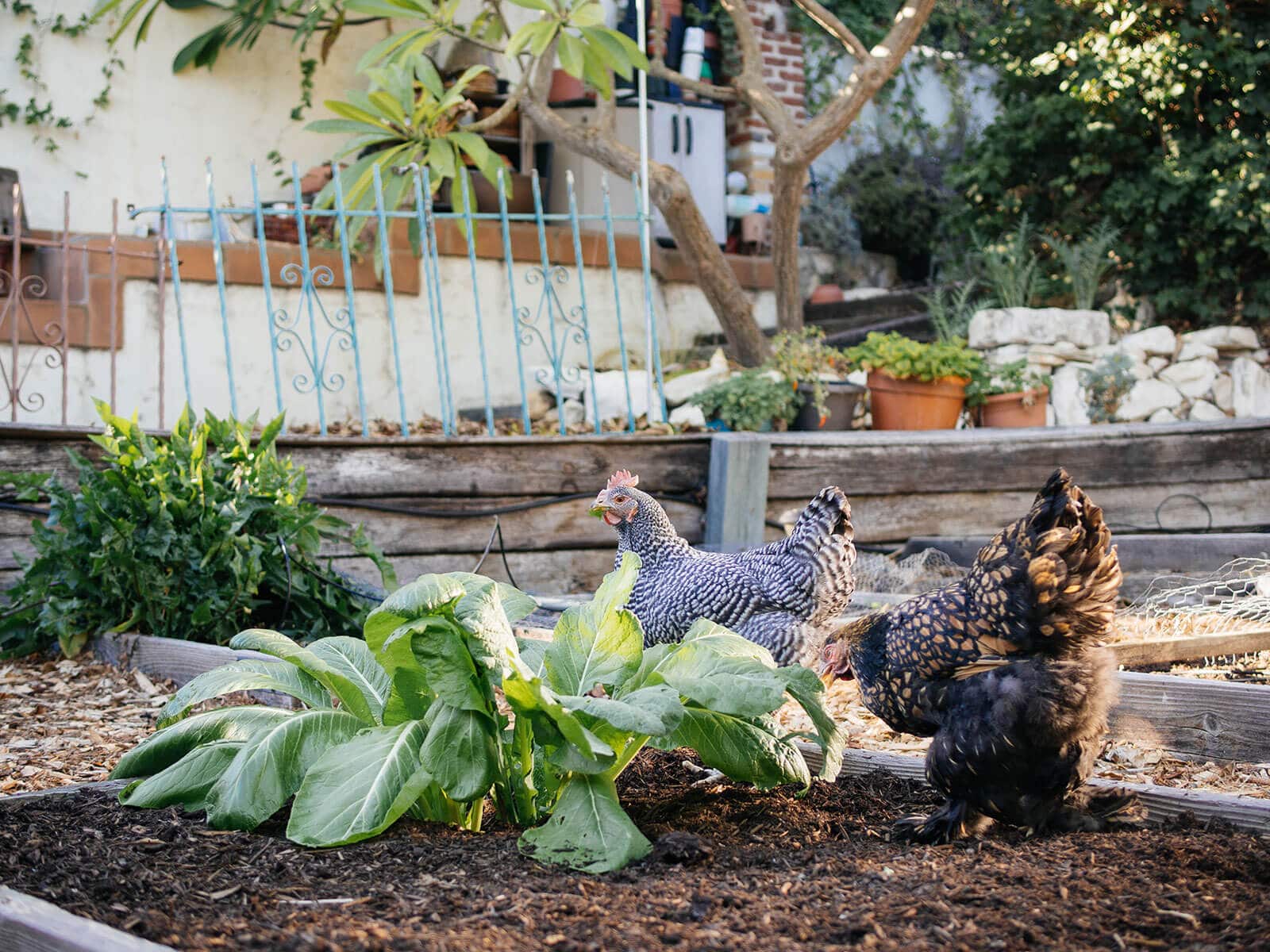
Why should chicken feed be soy-free and organic?
Because of its cheapness, availability, and high amount of protein, soy is a large part of a commercial chicken’s diet. But it’s also an incomplete protein, an unnatural source of food, and a highly processed food.
As with anything highly processed, soy has potentially harmful health effects ranging from vitamin deficiencies to hormone disruptions—especially when consumed in the crazy amounts that our culture does.
Soy is one of the most genetically-modified foods in the world, and it’s included in almost everything we eat. I know I can’t avoid it in my diet, but I can limit my intake of soy by choosing not to feed it to my chickens. You are what you eat.
(A pro-soy study found that soy protein transferred to the egg yolks and tissues of commercial chickens—even commercial “organic” chickens—fed a predominantly soy diet.)
An all-organic feed was originally not as important to me as a soy-free feed. I felt the benefits of a whole grain diet outweighed those of an organic (but processed) diet.
As it turned out, my homemade poultry feed is almost all organic, thanks to bulk purchases from Azure Standard and my local supermarket.

How much does DIY chicken feed cost?
My homemade chicken feed actually costs the same as the commercial poultry feed at my local feed store. This may not be true for everyone, but on the west coast, a premium bag of soy-free, organic layer pellets averages $0.70 per pound.
My soy-free, almost organic, whole grain feed costs $0.69 per pound (and would even be less if I purchased in larger bulk quantities—but I have a small flock and very limited storage).
This isn’t cheap chicken feed by any means, but it’s also not exorbitantly expensive considering the quality ingredients that go into it. You can lower the cost by going in with a fellow chicken-keeper on 50-pound bags of grains, or by using animal-grade ingredients instead of human-grade (which is what you’ll find in feed stores, and they’re perfectly acceptable).
An unexpected advantage of mixing my own feed is that I can share a lot of the grains, legumes, and seeds with my chickens, and I even use some of the same grains in my homemade dog food.
The ingredients are all human grade and mostly organic, and the fact that they can feed the whole household makes buying 10- or 25-pound bags of grains more feasible.
While there was a lot of legwork in the beginning to make my own recipe, the payoff is learning more about nutrition than I ever thought I would and knowing what goes into my chickens’ food (and ultimately, what goes into me).
I mix a new batch of feed two or three times a month. It feels like garden therapy. I have a strange love for running my hands through a mountain of whole grains.
It’s not any more work than refilling the feeder with bagged feed, and I have the option of changing up the mix every once in a while, rather than being stuck with the same 50-pound bag of commercial feed.
(This is advantageous if you have a mixed flock of chicks, pullets, and/or layers with varying protein needs, or want to alter their diet in winter or summer. I cover the nutritional needs of different age groups in my post that helps you calculate protein for your own chicken feed.)
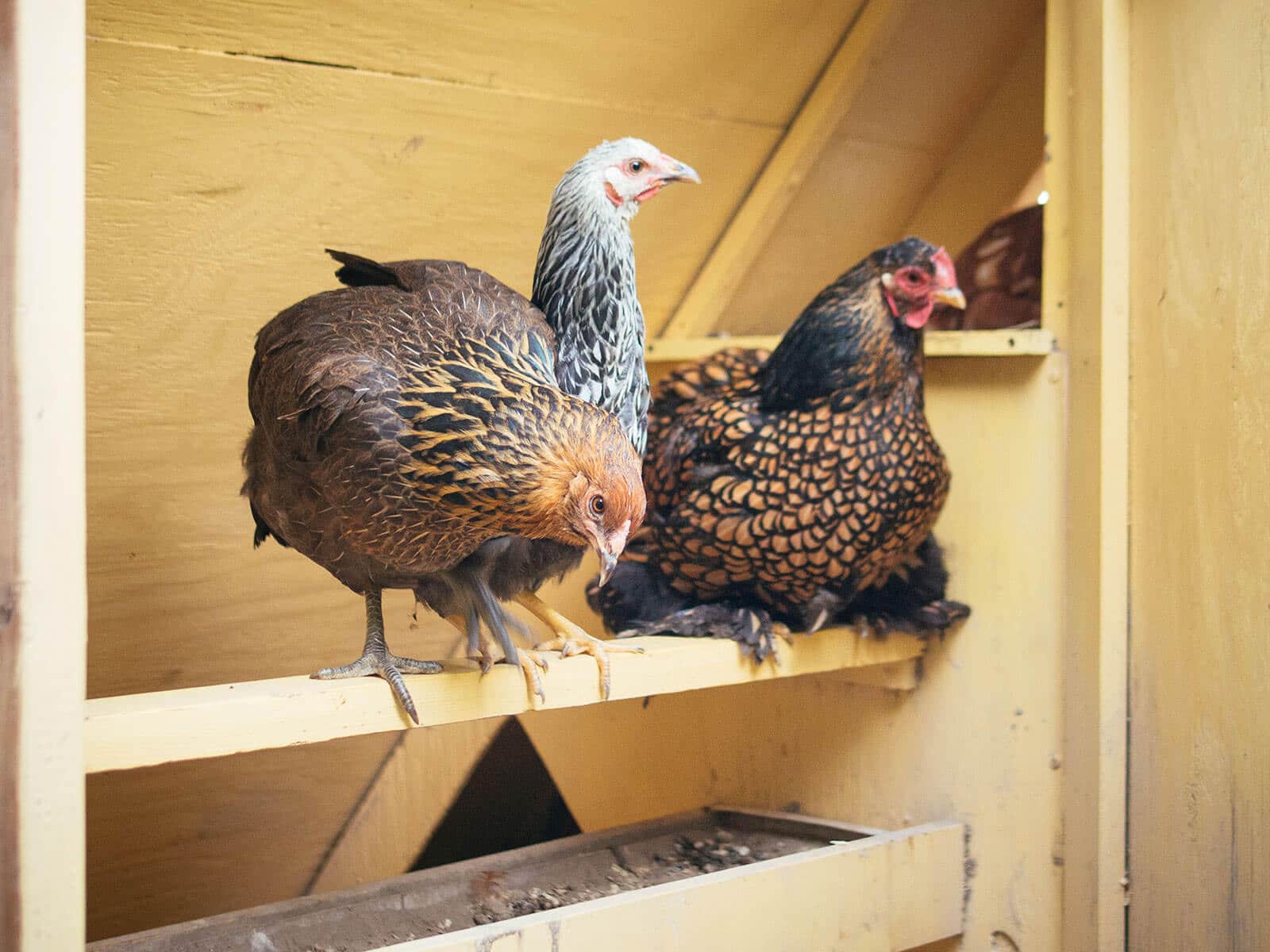
How do you find all the ingredients for homemade chicken feed?
Most of my grains are purchased from Azure Standard. As a natural food co-op that delivers nationwide, Azure Standard carries bulk bags of hard-to-find items like kamut and kelp, and sometimes at a better price than Amazon.
The rest of my ingredients come from local stores with a wide variety of bulk grains. (WinCo Foods was my go-to in Southern California, and still my favorite for cost, selection, and convenience. Market of Choice is my current stop in Central Oregon when I need a last-minute refill or want to try something new.)
You can find more exotic grains at places like Whole Foods Market, Sprouts Farmers Market, and in countless other natural food grocers and bulk food markets.
Your local feed store or grain mill will also carry the basics like oats, wheat, millet, and corn.
Oyster shells and grit are common ingredients found at any feed store or farm/livestock/poultry supplier.
How do you store all the whole grain ingredients?
Whole grains store for a very long time in cool and dark locations. Unless you go through a lot of feed quickly, I wouldn’t suggest keeping the grains in their original bags once opened, because weevils and rodents will think they’ve scored a buffet.
If you have a lot of space or a lot of chickens, you can dump all your ingredients into a clean metal trash can with a lid or a large galvanized steel bucket with a lid, mix them all up, and scoop out from there.
If you lack adequate space or keep a small flock, like I do, you can store the ingredients in airtight bins and mix as you go.
I scoop everything into a flexible bucket, give it a good mix, and pour the fresh food into the feeder. It’s like Christmas Day for the chickens… multiple times a month!
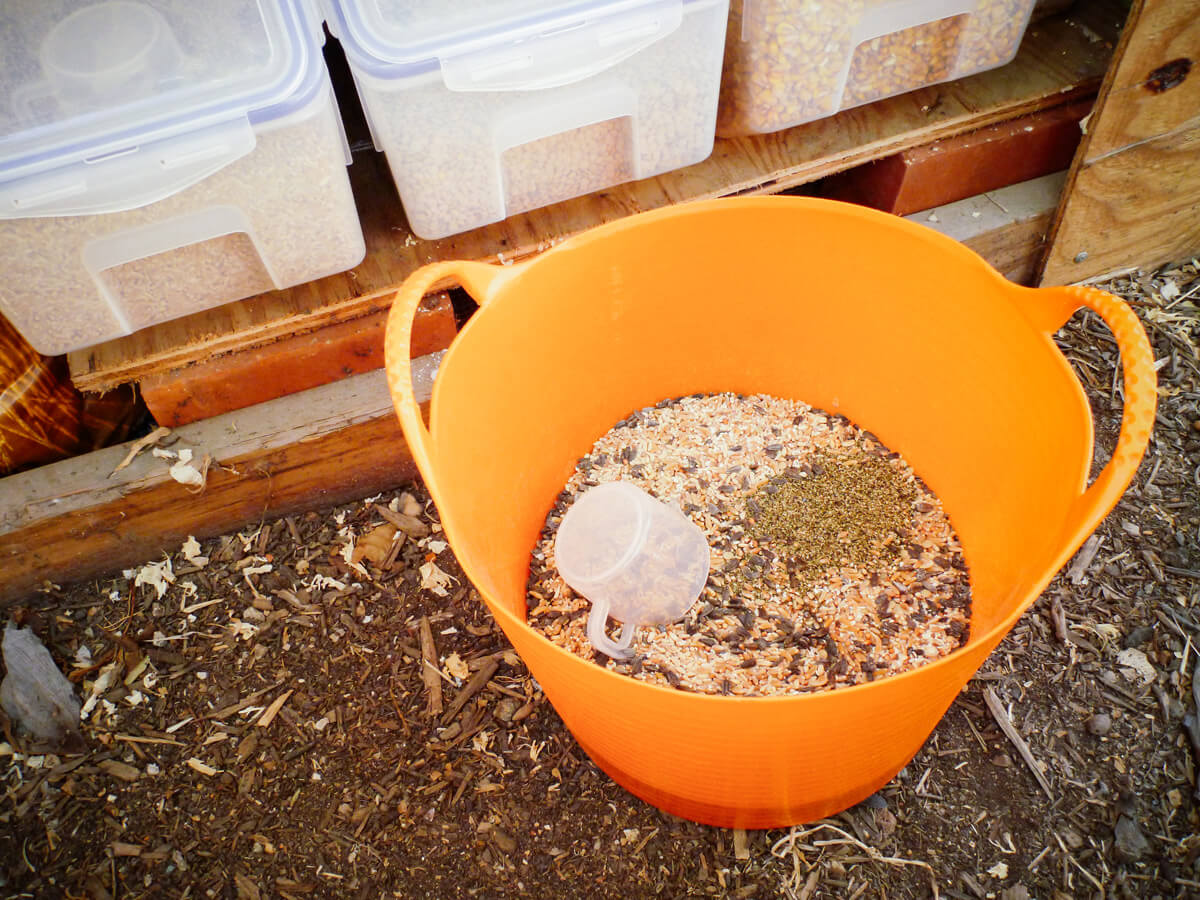
Update: Since this post was originally written, I’ve moved on to a new chicken coop that doesn’t have on-site storage, so I keep all of my grains and seeds in the garage. I’ve also added a few other containers — that I like just as much, if not more than my first containers — which are all linked in my sources at the end of this post.
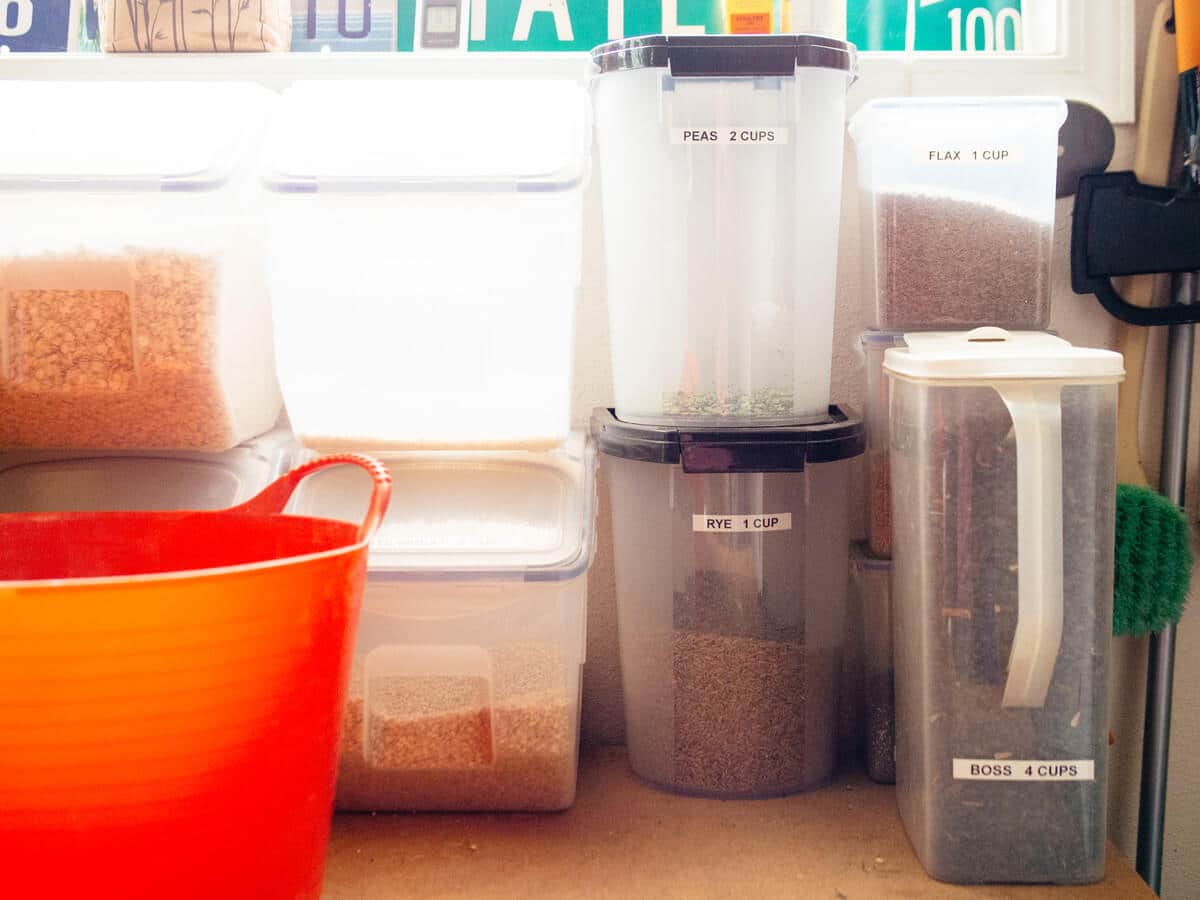
How do you switch a flock from crumbles/pellets to whole grains?
Start by gradually mixing in a little bit of whole grains into your chickens’ current feed to adapt their gizzards.
If they don’t forage frequently, make sure you offer them grit in a separate, free-choice feeder (I use this one).
Chickens don’t have teeth, so they swallow a small amount of grit and store them in their gizzards to grind up food. This is especially important for whole grains that need to be broken down.
Increase the amount of whole grains in their feed each week, until eventually you’re only feeding them whole grains. It may take a few weeks for your chickens to adjust to the change, so don’t be alarmed if egg production drops off a bit.
They may also start flinging grains all over the place (you’ll soon learn what they like and don’t like) or picking out certain grains first. (I believe chickens know what their bodies need nutritionally, so some days they may feed on more protein, less calcium, etc.)
Because of this, it’s a good idea to start with small amounts of different grains and seeds, and see what your chickens will eat before buying in bulk.

How much protein do chickens need?
My homemade chicken feed is around 17 percent protein, which is in the target range for laying hens.
This is a good number to know if you’re only feeding whole grains. But if you supplement their diet with pasture, scratch, mealworms, and kitchen scraps, all that food will increase (or decrease) the amount of protein they take in each day, so don’t get too hung up on the number.
The cool thing about making your own feed is being able to custom make it for your flock. You can make this chicken feed in bulk if you have a larger flock, just scale the recipe accordingly.
Keep reading for lots of suggestions and alternatives so you can create the best homemade chicken feed for your flock!
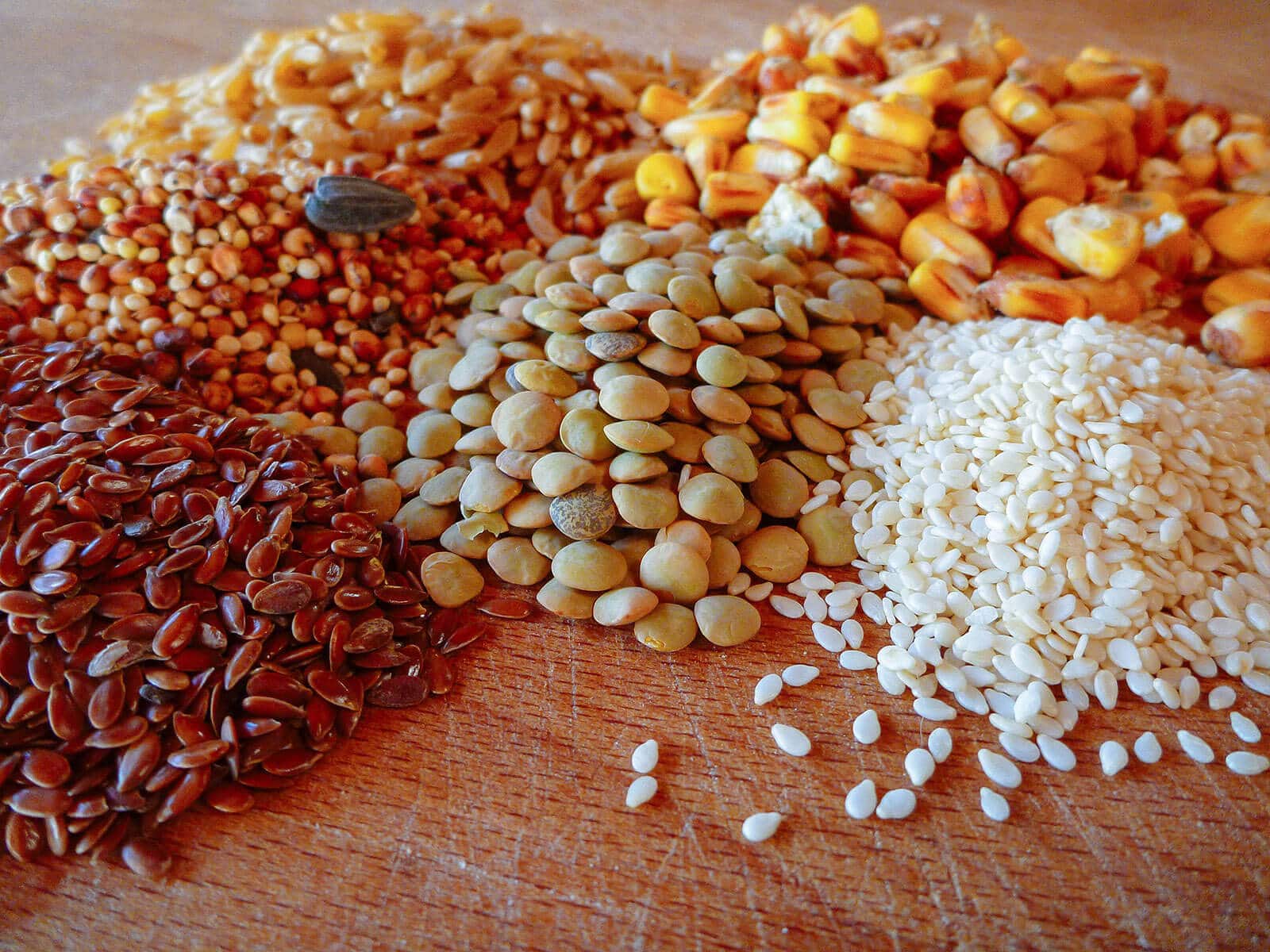
Garden Betty’s Homemade Whole Grain Chicken Feed
Makes 8 1/2 pounds (fills 10-pound feeder)
Ingredients
4 cups oat groats
4 cups black oil sunflower seeds
4 cups hard red wheat berries
2 cups soft white wheat berries
2 cups kamut
2 cups millet
2 cups whole corn
1 cup lentils
1 cup sesame seeds
1 cup flax seeds
1/2 cup brewer’s yeast
1/4 cup kelp granules
Free-choice oyster shells
Free-choice grit
Oats are rich in protein (around 16 percent), B vitamins, calcium and fiber. Oats are also a good (and cheap) source of energy. All oats—no matter how they’re processed—are nutritionally similar, so you can feed oat groats, steel-cut oats, rolled oats, and quick oats interchangeably.
Black oil sunflower seeds (often called BOSS) are like candy to chickens. But good candy! BOSS is high in protein (averaging 17 percent), rich in minerals and vitamins, and the high oil content gives feathers a beautiful gloss. BOSS is typically found in the bird seed aisle at pet and feed stores, and I buy mine from a local farm and garden store. You can also substitute striped sunflower seeds (the seeds that are typically packaged as human snacks), but they tend to be larger than BOSS with thicker shells.
Wheat is a major energy source for chickens. If you can find both varieties, buy hard red wheat and soft white wheat for the best nutritional balance. Otherwise, feed only hard red wheat, as it contains more protein (around 15 percent).
Kamut is actually a brand of khorasan wheat, but these days the grain is simply known as kamut… the way kleenex is synonymous with tissue. It’s an ancient Egyptian grain that’s nutritionally superior to other wheat in terms of protein (18 percent), magnesium, zinc, and vitamin E.
Millet (unhulled) is found in most bird seed, and in fact, the millet I buy is a mix of red and white millet sold at the store as “wild bird food.” It’s less expensive than human-grade hulled millet, but still rich in amino acids and iron. Feed stores sometimes label the unhulled white millet as “proso millet” (not to be confused with spray millet, which is a long and thin seed head).
Whole corn is a fairly large kernel, so depending on your chickens, you may have to crack or grind the corn first. You can also feed popcorn kernels, which are half the size and easier for smaller breeds to pick up. Corn is low in protein, vitamins, and minerals, but it does provide energy and fat (which is especially helpful in winter).
Lentils are very high in protein (at least 26 percent) and if your chickens take to them, it’s worth adding more to your feed. Mine don’t particularly care for lentils or any legumes, for that matter, so I only add a small portion to my feed.
Sesame seeds have one of the highest amounts of protein in a seed (around 25 percent), so they’re especially good for picky chickens that won’t eat legumes. They’re also one of the more expensive ingredients in my feed, so I add them sparingly.
Flax seeds boost omega-3 fatty acids in eggs, and are also rich in protein (37 percent), B vitamins, and minerals.
Brewer’s yeast (animal grade) can be found online or at local feed stores. You can buy human-grade brewer’s yeast too, but you’ll end up paying double (at least). It’s an important source of B vitamins and protein (around 35 percent) for chickens. (On a side note, I’ve also read that feeding brewer’s yeast to your dog will repel ticks and fleas, in addition to providing all the other good stuff.)
Kelp granules (or kelp meal) are basically little bits of dried seaweed. Kelp contains essential vitamins, minerals, amino acids, and salt that your chickens need. It promotes healthy growth, increases egg production, and darkens yolk color—an overall superior supplement.
Oyster shells provide the necessary calcium to strengthen your chickens’ eggshells. Feed this free choice, and they’ll take what they need each day. You can also feed them clean, crushed eggshells to put all that calcium back into their bodies.
Grit is typically limestone or granite gravel that aids the gizzard in grinding food. If your chickens free range, they’ll probably pick up little stones on their own and won’t take as much from the free-choice grit.
Other good sources of protein include triticale, field peas, and split peas (or any peas in general — many soy-free commercial feeds rely on peas to provide sufficient protein).
If money is no object, you could also add quinoa, spelt, wild rice, amaranth seeds, nyjer seeds, hemp seeds, or shelled peanuts as excellent protein sources.
Feeding lower-protein grains like rye, barley, buckwheat, and sorghum (milo) in small amounts will balance the higher-protein (and usually higher-cost) grains.
Try not to make your feed too heavy on any particular grain. The University of Kentucky College of Agriculture offers good information on the pros and cons of common feed grains on their Poultry Extension site.
At the end of the day, if you feed a balanced meal of grains, greens and garden pests—with a little treat here and there—numbers are not as important as a diverse diet.
Where to buy chicken feed supplies
[show_shopthepost_widget id=”3116483″]
Lock & Lock Bulk Storage Bin | Lock & Lock Square Tall Food Storage Container | Buddeez Plastic Storage Container for Pet Food | Iris Nesting Airtight Pet Food Container | Tubtrugs Storage Bucket | Miller Baby Fig Feeder | Little Giant Galvanized Hanging Feeder | AniMed Pure Brewers Yeast | Starwest Botanicals Organic Kelp Granules | Scratch and Peck Feeds Oyster Shell | Scratch and Peck Feeds Grower Grit
Homemade Corn-Free Soy-Free Chicken Feed With Whole Grains
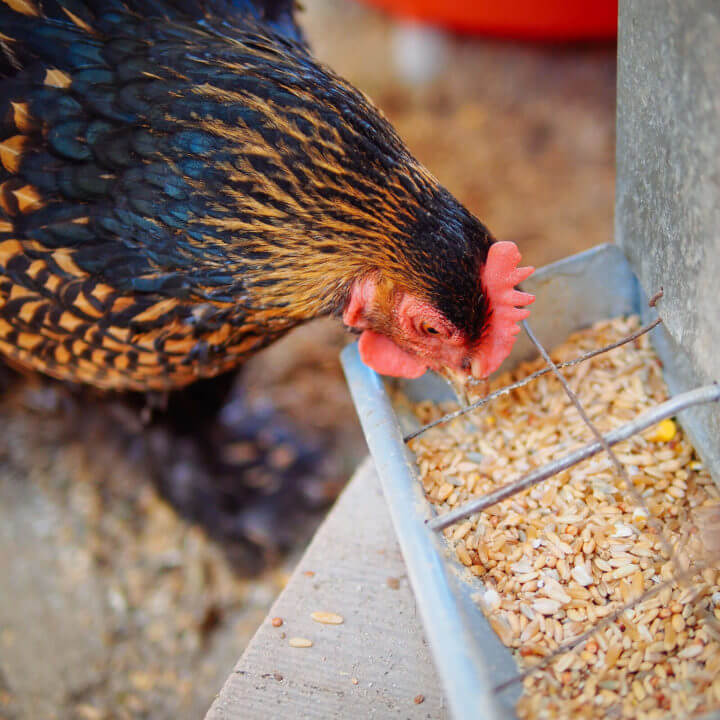
Garden Betty's homemade whole grain chicken feed just got better. This new recipe is corn-free (as well as soy-free) and makes the perfect feed for your favorite layers.
Ingredients
- 4 cups oat groats
- 4 cups black oil sunflower seeds
- 4 cups hard red wheat berries
- 2 cups soft white wheat berries
- 2 cups triticale berries
- 2 cups rye berries
- 2 cups millet
- 2 cups sesame seeds
- 1 cup flax seeds
- 1/2 cup brewer’s yeast
- 1/4 cup kelp granules
- Free-choice oyster shells (or crushed eggshells)
- Free-choice grit
Instructions
- Combine all of the ingredients, except the oyster shells and grit, in a small bucket.
- Fill your feeder with the mixed-grain feed, or store the feed in a pet food container or a galvanized steel bucket with a lid.
- Offer the oyster shells and grit in separate small feeders for your chickens to eat as they wish.
This post updated from an article that originally appeared on June 29, 2012.
View the Web Story on homemade whole-grain chicken feed recipe.


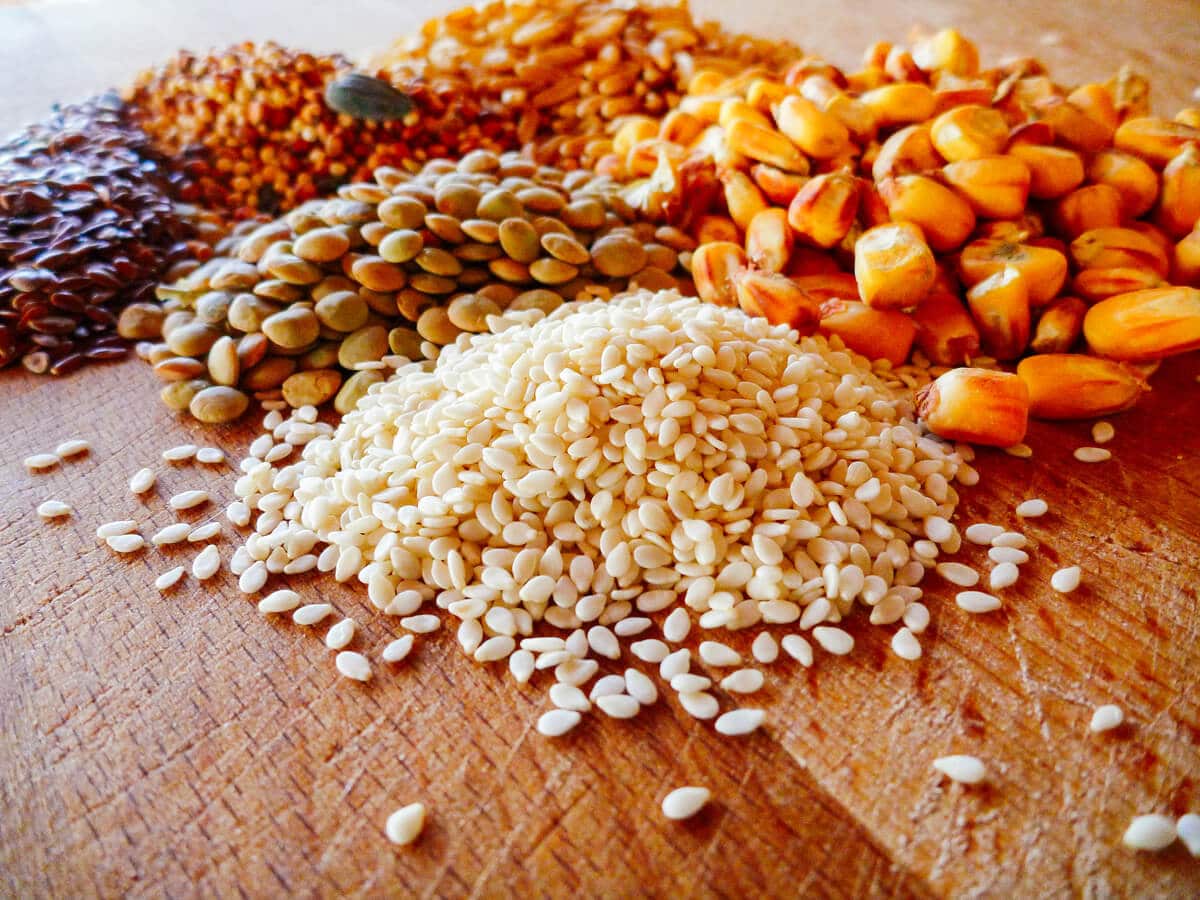

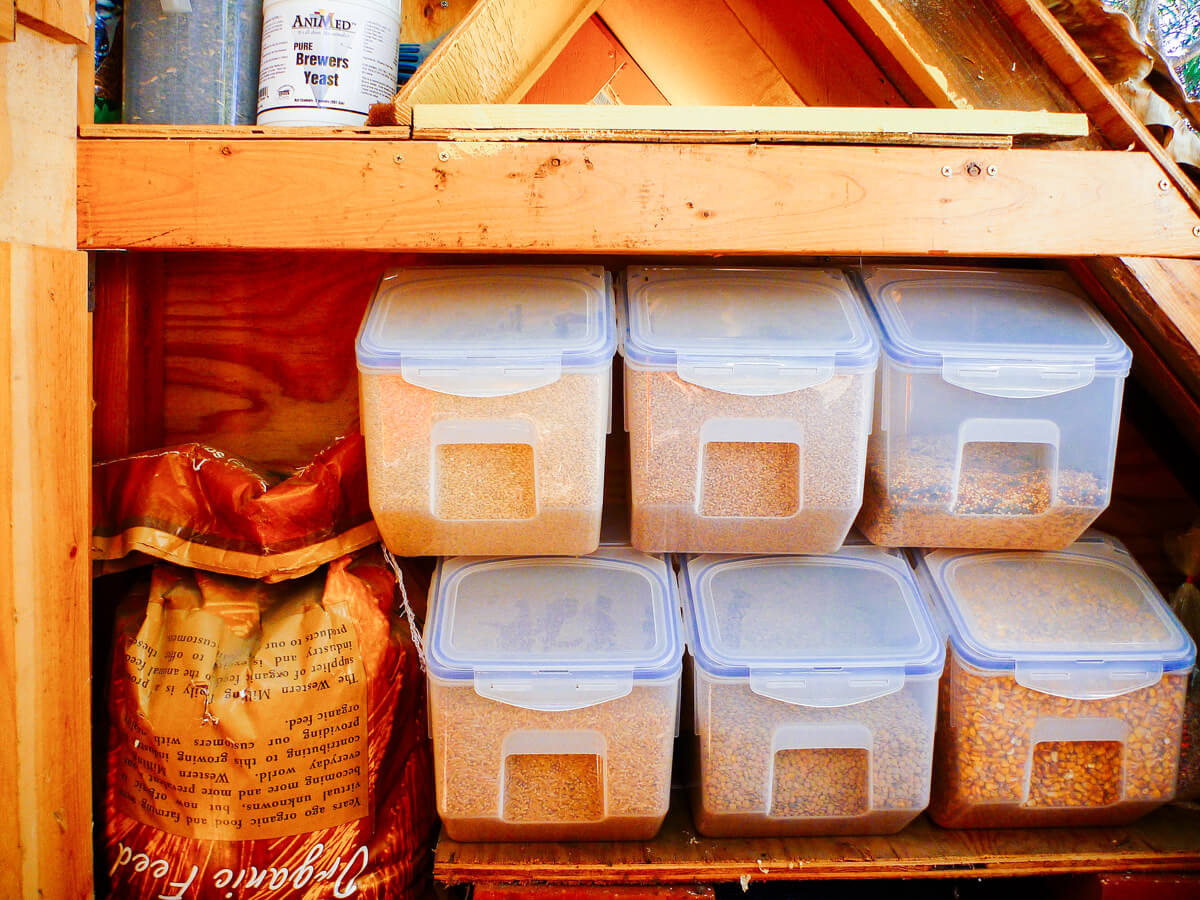
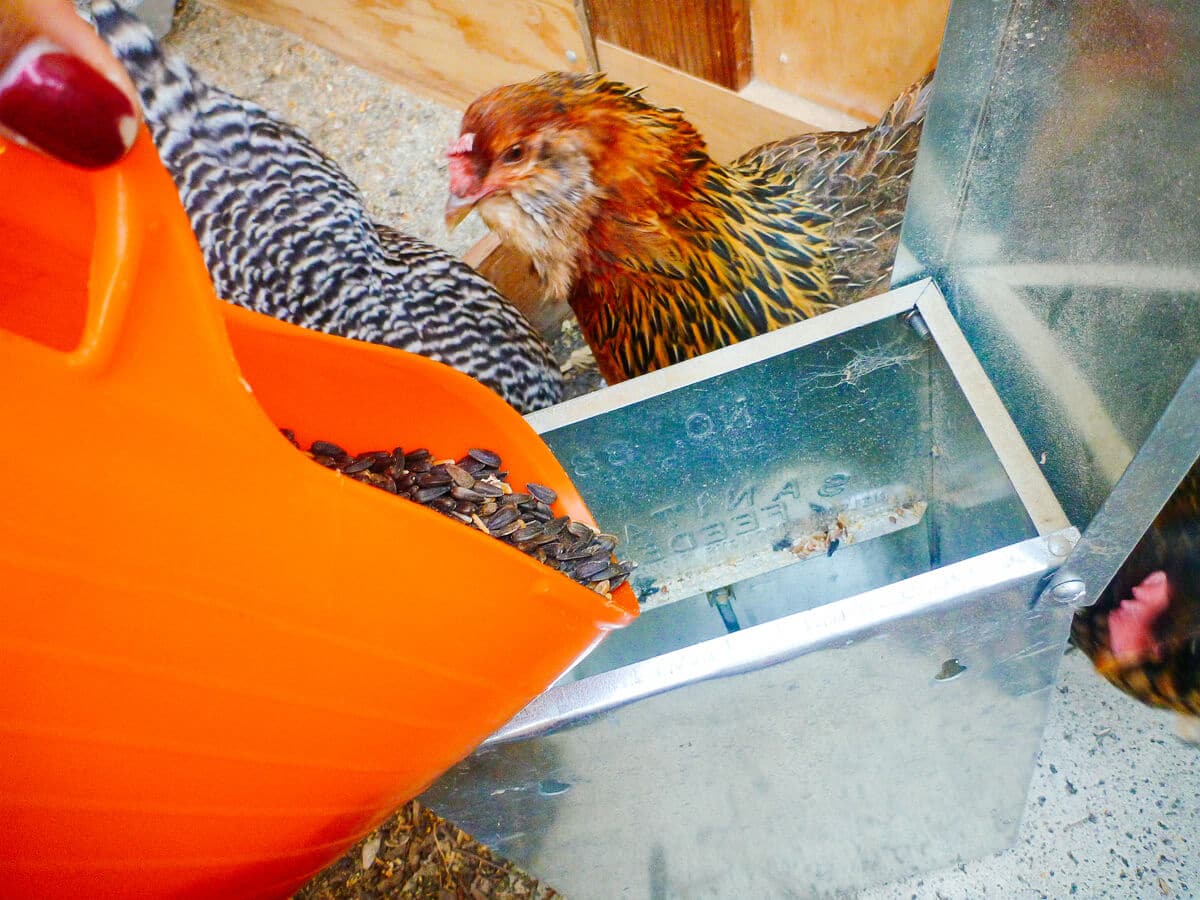













Hi, thank you so much for posting on this topic. I’ve been looking for a homemade organic feed recipe for quite some time but found none that I thought suited me and my chickens the best; however, your recipe sounds great and I will give it a try. Thanks again!!
Hi there! I’ve had chickens for 2 years now. Love ever second of it. I was so happy to have found this recipe for making my own food for them rather than buying the crumble or pellet food which always smells like hops. Anyway, I my ladies refuse to eat the wheat, Kamut, lentils, flax and peas. I don’t know what to do. I am refusing them more food until they eat what I gave them. I know they won’t starve. They are free range and eat the food I provide them at will however, I am wondering if there are any other alternatives? I want to mix my own but I want to be sure it’s balanced like this recipe seems to be. Any suggestions or recommendations are welcomed. Most Sincerely, Amanda
If you read through all the comments, you’ll find plenty of high-protein alternatives for the grains/legumes your chickens refuse to eat. It’s best to just browse the bulk aisles of your local health food store and buy small quantities of different grains for your chickens to try. With any diet change, it takes time for your chickens to get accustomed to the food and the switch should be gradual.
Hi linda i have chicks and chickens and i want to get Quail and they all have different protein needs. your recipe is for 17% protein how did you calculate it out to be that and how would i be able to make a 30% feed
I calculate by weight so that it’s more accurate, but also a tad more complicated. This was my process:
1. Find the protein content of each ingredient (e.g. oats = 16% protein).
2. Weigh each portion of the mix (e.g. 4 cups oats = 1.63 lbs).
3. Divide each portion by the total weight of all ingredients (e.g. in a mix weighing 9.26 lbs, oats = 17.6% of the mix).
4. Multiply the ingredient’s percentage (17.6%) by its protein (16%) and you’ll find that oats = 2.8% protein in the mix.
Do this for every ingredient and add up all the last figures. It’s easiest to put this all in a spreadsheet so you can calculate numbers on the fly as you adjust the values. Hope this helps!
Hi thank you for the info its very helpful. I have one more question, i have access to hemp seed, is that high in protein and safe for my chickens to eat?
Yes and yes!
So excited that 4 chicks arrive next week, but am rather nervous as too what to feed them. We want our chickens to be happy, healthy and organic from Day 1, so I was wondering if you have a recipe for food suitable for them?
If you read through all the comments here, you’ll find many suggestions on how to adapt this recipe to chicks. Enjoy your new babies!
This is a wonderful post! Thank you for providing the great, very complete information.
A side question, where did you get the bins that you store your seeds/grains in?
Thank you!
I forget what they’re called, but I link directly to their Amazon page in my post!
Awesome! Why go to all the work of growing your own eggs and then eat GMO’s!? Thanks for sharing this!
Hi LindaBetty—I have been searching everywhere but have not found a good solution yet. My 6 sweet chicks are 10 wks old. So I’d like to get this figured out pretty soon—We are all allergic to wheat in this house, especially my youngest son (wheat really affects his ability to THINK – very frustrating for him at school!) I would lovelovelove to mix whole grain feed which is soy-free, corn-free, wheat-free for my chicks. Is that combo even possible??!! I also live in so cal, and there is even an azure standard delivery point near me. Can you please suggest some substitutions for wheat or direct me to some links or sites you know of? I would be so happy and relieved if I could get this figured out! I’d be so grateful for any wisdom you could provide. Many Many Thanks 🙂
Have you taken a look at my corn-free feed? http://gardenbetty.com/2013/04/homemade-whole-grain-chicken-feed-updated-and-now-corn-free/
I am not completely familiar with wheat intolerance, as sometimes people can still tolerate rye and barley… but those are two options if they’re doable (save the rye for when they’re laying), along with triticale (which I use in my corn-free mix), buckwheat (not a wheat, despite the name), brown rice, wild rice, sorghum/milo, different varieties of millet, split peas, field peas, amaranth, or quinoa (although these last two might be cost-prohibitive). As long as you don’t go too heavy on any one of these grains or legumes, you should have a properly balanced feed without any wheat.
I am confused on how you came up with the cost. I am not good at math but the way I see if you are making this mixture 2 times a month for 3 hens and I am seeing it cost about 60 a month in feed this way using the prices from Azure is that right? I pay 25 bucks a bag for NON GMO feed from my feed store….and it lasts me 3 weeks with 13 chickens. Please tell me I am doing something wrong because I would love to make my own feed.
I only mix 8.5 lbs of feed at a time. My feed is $0.69/lb x 8.5 lbs = $5.87 x 2 (refills per month) = $11.74 per month. (Your monthly cost will obviously be more since you have more chickens. However, your per-lb cost might be less since you could buy larger bags of grains.)
I calculate my per-lb cost for each grain, then weigh all my ingredients to calculate my per-portion weight. I’m not sure how you arrived at your other figure but keep in mind some ingredients (like BOSS) cost more per lb but weigh very little, while others (like wheat) cost less but weigh more.
i’ve been scrolling through all of these messages and I can’t seem to find how much of this recipe you fee each chicken per day. I would love if you could tell me how much each individual chicken should get per day or if you feed them twice a day? HELP!
I leave it all out for them in a feeder. This recipe lasts about two weeks, but my three chickens also forage in a yard all day so it’s hard to say how much grain they actually eat in a day.
i started to raised chickens june 2013. still till this day i have no idea on how much food to give my chickens. everybody i have asked or looked up on the computer never say how much to feed them. i have 21 hens, 5 rooster, 15 babies, and 1 baby turkey. in a few days i will get 5 more baby turkeys. I don’t want to starve them or waste the food, its very pricey. They have been stuck in their coop for the last couple of weeks because of the HAWKS. they get plenty of treats but still would like to know how much food per chicken and baby chicken. Just wanted to say that i’m very interested in your homemade food recipe for chickens. I thought what the crumbles i bought was suppose to be good for them. now I’m having second thoughts. thanks
The reason why there’s no definitive answer on how much to feed your chickens is because chickens, like people, all eat very differently. Mine eat more in summer and less in fall/winter. They eat less grain when they’re out foraging all day, but more grain when they’re hanging out inside the coop waiting for a storm to pass. They fill up on weeds and grubs in spring but don’t find as much on the ground in winter. The amount of treats or kitchen scraps you give them also affects how much grain they eat.
It’s especially difficult to determine how much your chickens eat if they share the same feeding area as your roosters, babies, and turkeys. You really just have to take mental notes on your flock’s feeding habits over time. If they eat everything that you put out right away, give them more. If there’s a lot of food left at the end of the day after they roost, you can maybe cut back. Feel all of their crops at sunset, after they’ve gone to bed, and make sure they’re nice and full. Their crops should feel a little larger than golf balls – hard and round. A squishy crop means they’re not getting enough food.
Thank you so much for your amazing recipes and information on organic feeding! I read your blog several weeks before purchasing my peeps and decided organic was the way I wanted to go. I have 11 peeps now ages 3 days to 2 weeks, and after a week on chick starter feed I sprinkled in a few tsp of about 1/3 of the seeds listed to introduce it slowly. They literally came running up to me the first time I mixed it and started pecking it straight out of my hand! Even the tiny babies fought for a taste of the quinoa and barley. I did break the lentils a little and mine gobbled them up. I am so excited that you posted this and I know my peeps are thanking you too! Looking forward to having a flock of super healthy hens by summer.
So happy your girls are hooked on the whole grains, and hope they’ll be giving you some amazing orange-yolked eggs in a few short months!
Have you tried fermenting this mix to reduce intake (and therefor cost)? I plan on using this (or the corn free) mix once my chicks age into conventional feed possibly, but fermenting their feed now and likely to continue to do so for health and cost benefits.
I ferment feed every once in a while, usually leftovers (without the brewer’s yeast) or scratch. It works well, but my chickens also forage all day (on 2,500 sf of “pasture”) and get scraps from my kitchen… I’m not sure if I’d see a major gain in health or cost savings (especially with only three chickens).
Any links for whole grains for ducks?
I’d imagine ducks and chickens eat the same feed (as they’d forage for the same things in the wild) but I’m not too familiar with their specific protein needs as they grow from duckling to adult.
What would you replace the corn with in this recipe? (I did see your corn-free post, but my birds aren’t laying yet, so I need to avoid the rye). They do eat peas/legumes, so maybe it is easier to modify this original recipe? I’m new to chickens altogether, never mind making my own feed, so any suggestions are appreciated!
I think it’s easiest to replace the corn with split peas, as pullets can use a little more protein than layers.
Is there something we can substitute for whole corn? It’s impossible to find corn that is not GMO in my area.
Thanks!
I actually just posted a corn-free recipe this week: http://gardenbetty.com/2013/04/homemade-whole-grain-chicken-feed-updated-and-now-corn-free/
Curious do you leave the grains whole or do you run them through a mill?
I use them whole.
Thanks for an excellent (egg-cellent) recipe! I will use it on our new flock we are starting.
I just found your post. I have been researching before we get our own hens and have a question about the grit and oyster shell. When you say they are free choice, do you set out separate containers of those in along with the feed in the morning? How much feed can I expect to feed 3 hens per day? Do you know of a substitute for corn? Thank you so much for your help!
Yes, I set out two separate containers for the grit and oyster shell, and just leave them in the coop with the regular feeder.
The recipe above lasts my hens about 2 weeks, but they also get to forage every afternoon and I give them greens/kitchen scraps a few times a week as well.
You can substitute anything for corn without affecting the protein value of the feed, as it is very low in protein. Read through the comments, as there are quite a few suggestions for various grains and seeds you can use instead!
Alright, I’ve gotten most of my ingredients but had one other question…would Nutritional Yeast be ok in lue of Brewer’s Yeast?
The reason I add brewer’s yeast is because it’s an excellent source of B-complex vitamins. I’ve read that brewer’s yeast generally contains more B vitamins than nutritional yeast does, but this may depend on the different brands.
Hi! I have a question about adding amaranth and quinoa. I’m in Bolivia right now, so both of these are easy to get, but usually for people to eat them without a stomachache you have to wash them a million times, because of the saponins. In the US I think it was pre washed, but here, would I have to wash and dry all of the quinoa before giving it to my hens, or adding it to the food? We just bought 3 cute pullets, about 4-months old, but it’s our first chicken experience. 🙂
No, you don’t need to wash amaranth or quinoa before feeding them to chickens. Naturally, they’d just eat them off the plants anyway. (I’ve grown a lot of amaranth specifically for my chickens to snack on the seed heads.)
Thanks so much for your site, I am loving it! I am going to be getting baby chicks soon and I want to use your recipe. I know I will need to increase the protein, what is your suggestion for the easiest way to meet my chicks diet needs. Also, I planned on grinding down most of the ingredients, does it need to be in an almost powdered form? I bought the BOSS already but those seem like they might be hard to grind down. I would love to hear any input you may have. Thanks again! 🙂
A powdered form is not necessary, as baby chicks can eat smaller grains like oat groats. So, you can just crack the grains, including the BOSS. BOSS does contain a lot of oil though, so I’d crack them as needed to prevent rancidity. (If you do grind everything into a powder, it’s better to turn it into a wet mash – by adding a little water – so that the food isn’t wasted in the form of dust.)
As far as increasing protein, you could simply add another few cups of high-protein grains to this recipe (and maybe scale back on the wheat, millet and corn). Try split peas, cracked peas (of any kind), lentils, triticale, quinoa, sesame seeds, or amaranth seeds.
Also, do provide chick grit for digestion, but do not give them oyster shells. Chicks do not need extra calcium.
Great, thank you so much for the info!!!
Hi! I’m having a hard time finding whole corn in bulk. Can I use popping corn? Also, I’m getting chicks in just a couple days and was reading through the comments. Can I use popping corn for them as well or just corn meal? Thank you so much. My ladies LOVED the first batch I made 🙂
Oh! I was also planning on substituting quinoa for the kamut, my ladies didn’t seem to like it as much. Is that ok? Or is there something else?
Quinoa is rather expensive but is a great substitute.
If you want something cheaper, but still high in protein, I recommend triticale. I’ve been feeding that in lieu of kamut lately, and my chickens love it. I’ll probably make the switch permanent because of the better price I get for it.
I can’t find the ancient grains where i live, i just have the basic red wheat, oats, flax, and rye. Iam even finding it hard to get the kelp and yeast. Is it okay if i omit the kamut or maybe just add something a little more readily available, if you could give me a few ideas that would be great. Also i live in canada and in a northern community(remote) i most likely have to give my birds the alfalfa meal and the poultry nutri-balancer
how much would you suggest to incorporate into your feed?
You can replace the kamut with any high-protein ingredient. Try split peas, field peas, or add an extra cup each of the lentils and sesame seeds.
I’m not familiar with portion sizes for alfalfa meal, but if you can find a bale of alfalfa from a feed store or ranch, you can leave that out for your chickens to peck at. Or, add a couple cups of alfalfa pellets to your feed during the times of year when greens are scarce. For the Nutri-Balancer you would need to ask the manufacturer for serving suggestions; I have never used it.
Hi i was wondering can beans be interchangeable with the split peas and lentils they all are pretty high in protein
Hi i forgot to ask about kelp granules, i can only find them online and they are for humans and rather expensive. I seen them advertised as an organic fertilizer 100% natural for a quarter the price, would they be okay to give my chickens?
I honestly don’t know the difference between kelp as a health supplement and kelp as a garden fertilizer. Personally, I’d only use human or animal-grade kelp. Try looking for kelp meal or kelp powder, if that helps.
Dried beans contain a compound that is toxic to chickens (and most birds in general). I don’t know what amount causes toxicity, but I’d refrain from using them as part of your feed. (Dried or undercooked beans are also toxic to humans.)
Where are you getting the triticale?
Yes, you can use plain popcorn (unpopped). For chicks however, I’d recommend corn meal as popcorn kernels may be too large for them.
So happy you’ve had success with it!
Hello, I am wondering what the cost is to make your own organic feed? What are you paying? I am not sure if it is worth my time to make my own. Currently I am paying $35+tax for 50lbs of Organic Feed. Thank you 🙂
It depends on where you live and where you buy supplies. In LA, commercial organic feed is about $0.70/lb (though I don’t live near a feed store that carries it) and this recipe costs me $0.69/lb (but is easy to source locally), so it’s only marginally cheaper. I could actually get my cost down even more if I bought in greater quantities (50-lb bags instead of 25-lb bags).
The real value to me is knowing exactly what goes into my feed. Even if you decide not to make your own, you can use this recipe as a base for choosing a good commercial feed as you’ll know what ingredients are included and why.
I’ve been doing a lot of research lately on healthier and cheaper options to feeding my chickens. I love this post! I have come across fermented feed for chickens and other livestock. Do you think you could still ferment this feed but maybe leave out the brewer’s yeast?
Yes, you can ferment whole grains and seeds – it simply turns into a wet mash. I’d add some kind of starter to get it going quicker.
Is this feed safe for baby chicks? (Roughly 2 weeks old) I’m mostly curious to if they can have flax and hemp seeds, but would love to start making their food. I just know the babies have different needs/concerns. Awesome write up!
Thanks! Flax and hemp seeds are both good for baby chicks because they have very high protein levels, and chicks need more protein than pullets and layers do (around 20-22% vs. 16-18% for the older girls). However, I don’t remember how large a hemp seed is – a chick can handle a small grain or seed, similar to an oat groat. Anything larger should be ground or fed in meal/powder form.
You can use this same recipe, but replace the larger grains (like BOSS, kamut, corn) with shelled sunflower seeds, quinoa, corn meal, etc. Then add a few extra scoops of high-protein stuff like hemp meal, split peas, or amaranth seeds. And finally, always, always make sure they have access to grit (specifically chick grit, which is smaller) so they grind everything up properly in their gizzards!
Thank you! I have looked everywhere for a homemade recipe that was simple and didn’t involve weird ingredients, supplements, freeze dried worms (yuck).
I am wondering if there is something I could use instead of the kelp? My chickens have a fairly large area to free range but its covered with snow in the winter. Could I substitute with fresh fruits/veggies? If so, what types would be best?
Kelp is included in the recipe for trace minerals and salt. I don’t really know of a good substitute for all that kelp provides. Are you having trouble finding any form of kelp? I use the granules but it also comes as kelp powder, kelp meal, and seaweed. It’s sold as a supplement for humans, horses, dogs and cats (the only difference being human grade vs. animal grade). Or, you can look for dried seaweed in an Asian market. Sometimes it’s sold as a bundle of dried seaweed (like what you might find on the beach) and you can simply hang this in the run and let the chickens peck at it whenever they want.
I went to an Asian market and bought whole dehydrated kelp. I put it in my food processer and ground it until it was pretty fine and then I sprinkle some on their food and mix it in. It is not too exspensive and seems to go along way. Do you think this is a good idea?
That sounds like a great idea!
Can you feed oat with hulls on them?
Yes, since their gizzards grind everything up. Just make sure your chickens have access to grit.
Betty quick question, would this recipe work out if I excluded the corn? Also I was planning on premixing this feed and storing it in a plastic trashcan (new;not used) in my garage, would this be okay, or would it be better to store it the way you do?
Yep, you can replace the corn with any other grain (as corn is low protein anyway). I’ve recently started feeding my chickens triticale and rye (when the other grains are sold out) and they eat it all up!
A trash can works for storage, so long as the lid is secure. Annoying little vermin like mice and weevils have a way of getting into all that food if it isn’t, so be sure you close it tightly!
Hi, wow, I am so excited to start with my chickens. I haven’t gotten them yet but doing all the prep right now. I was wondering a couple things. One, how long does 8 1/2 lbs. last? I am thinking about three chickens also. I am worried about food because I don’t want to use conventional, but am afraid I won’t be able to find all the ingredients. Also, I am wondering if I can feed and keep a turkey with the chickens?? Just stumbled upon your site- really loving it!! Thanks!!
Oh yeah, one more question; what is considerd greens? Apple and pear scraps? Or just green things??
When I refer to greens, I usually mean green things, like lettuce, kale, collards, broccoli, etc.
Apple and pear scraps (as well as green scraps like the outer leaves of cabbage that you sometimes discard) are what I call kitchen scraps.
This recipe lasts my three chickens about two weeks. They do get to forage in the afternoons though, so I’m not sure how much they eat from their feeder vs. how much they find on pasture.
You definitely don’t have to worry about following my exact recipe, as many other seeds and grains will work just fine in place of something you can’t find. And who knows, your chickens might not like a particular grain, so there will be a fair amount of trial and error as you create a recipe that’s more suited to your flock.
I don’t really know much about turkeys. I’ve seen them housed together on farms, but you probably need plenty of space to keep all the birds happy.
I’m new to chickens and getting 10 new chicks in May. I plan to feed
whole grain, but I’m wondering what you feed them as little
chicks…will they eat whole grain already?Bridget
Hi just came across this site from random browsing about building your own feed for chickens. I happen to be in the flaxseed business and I’d like to comment that flaxseeds has a waxy outer coating that cannot be digested without heating or pulverizing in some way. So in a sense you (chickens and other animals) will just poop it out whole. If you check your chicken poop you can even see specks of flaxseeds in there! The best way to consume flaxseeds is to grind it up, say in a coffee grinder :). Can be keep up to 3 months frozen. 3 weeks in the fridge. They go rancid FAST because of the high oil content. So grind as you use or keep in freezer. Good luck!
I have to say that I constantly check my chickens’ poop, and have never seen specks of flax seeds (or any seeds for that matter) in them. Their gizzards do a good job of grinding everything up. If you are seeing undigested seeds in your chickens’ poop, I’d suggest adding grit to their diet.
I was told that uncooked lentils were a no-no…do you cook your lentils before giving them to the girls?
Uncooked lentils are safe for chickens to eat. I always add them to the feeder as-is (dried), but sometimes I’ll cook a cup of lentils and leave them in the coop overnight so the girls find a nice little treat in the morning!
We just got an Azure buying group together! Yip-pee! Question: Which grains did you buy from Azure and what sizes did you start out with?
I noticed that you do not include a supplement such as Fertrell’s Poultry Nurti-Balancer but did include kelp and brewer’s yeast . . . interesting.
Thanks!
All the grains in my recipe, with the exception of the BOSS, millet, brewer’s yeast, sesame seeds, and flax seeds, come from Azure. (Azure does carry the latter two, but I found them cheaper at WinCo.)
Since I only have 3 hens and limited storage, I bought 25-pound bags. I’ll be reordering soon and might buy 50-pound bags of the oats and wheat, since I go through those more quickly.
My hens free-range most of the day, so additional supplements aren’t needed. If yours don’t have access to pasture, or if you don’t feed them extra goodies like greens, mealworms, or leftovers, adding Fertrell’s or alfalfa pellets would not be a bad idea. (But, I think they’re only necessary for chickens that never leave their coop, or who live in northern climates with snow.)
The birds love the new rations; which I view as only one part of the diet. I grow pasture for them along with black soldier fly larvae they are happy birds! I also keep baled alfalfa on hand in case I am low on fresh greens (which isn’t often here in S. Cali).
I have 5 birds so I did go with a 50-pound bag on the wheat but rather than the lentils I went with a 25-pound bag of whole peas ($10.30). Plus groats, flax, milo, millet, kamut, triticale, sesame seeds, brewer’s yeast, and kelp granules. I did go ahead with Fertrell’s but the 60-pound bag will last forever! (Azure saves so much over our local co-op) And lastly a 50-pound bag of BOSS.
You have some lucky ladies!
Hi i was curious how much you buy of each ingredient in your list and how long it lasts just to give me a general idea of how much i should order. I have 4 chickens.
How long your food lasts depends on how much your chickens eat. Mine forage all day and get tons of garden treats, so the grains I buy last several months. If you’re just starting your chickens on this diet, you should order small quantities first to see what they like before ordering bags in bulk (and by then you’ll probably figure out how quickly they go through their food).
Can I use shelled organic sunflower seeds instead? I had found this recipe before yours and I was going to use it: It said shelled for the baby chick version but not this version, I was going to use organic shelled sunflower seeds, do you think that is ok?
2 parts whole corn (in winter this is increased to 3 or 4 parts)
3 parts soft white wheat
3 parts hard red winter wheat
1 part hulled barley
1 part oat groats
1 part sunflower seeds (in winter this is increased to 2 parts)
1 part millet
1 part kamut
1 part amaranth seeds
1 part split peas
1 part lentils
1 part quinoa
1 part sesame seeds
1/2 part flax seeds
1/2 part kelp granules
free choice of granite grit
free choice of oyster shell
PS I tired to share a link to an album I made on facebook so you could see my baby chicks, but it would not let me share it here.
Shelled sunflower seeds are absolutely okay! And when your chicks are old enough, you should switch them to BOSS, as the higher oil content makes them more nutritious.
You can also sprout a lot of the larger grains and seeds to make them easier to ingest.
Did you know that whole grains actually sprout in their gizzards? I discovered this while butchering some young roosters! They produce their own nutrients from the sprouted grains…amazing creations!
Fascinating! Thanks for the tidbit!
Nevermind I just read the answer: WinCo, is it organic?
Not organic… I haven’t found organic BOSS anywhere actually.
I get my Organic BOSS from Modesto Mills. We run a co-op here in San Diego and get it in bulk.
Good to know! I never saw that option on their site.
Hi Linda,
May I ask where you get your Black oil sunflower seeds? Azure does not carry them, thanks!
Thank you for the AMAZING write up! I just got 8 baby chicks a few weeks ago and I started making my own food last week. Your ideas are SO helpful and the bin/bucket links are awesome. You are super great, thank you SO MUCH! 🙂
You’re welcome! Your little chickies are very lucky!
Love this! I’m saving this, for the future chickens we’ll hopefully have, in my recipes folder (yes, right alongside the pie and lasagna recipes).
Cute!
I’m new to chickens and getting 10 new chicks in May. I plan to feed whole grain, but I’m wondering what you feed them as little chicks…will they eat whole grain already?
They can eat smaller grains such as oats and wheat, and shelled sunflower seeds. But you should crack or grind larger grains for them, or substitute grain meals for the whole grains, e.g. corn meal, etc.
Also, keep in mind that chicks have a different feeding requirement than layers. Chicks do not need oyster shells (calcium), but they do need extra protein while they’re growing. Commercial chick starters are around 20% protein. For your homemade feed, you can increase the lentils (or split peas) in my recipe, or add alfalfa meal.
Linda,
Thank you so much for this. I have been reading and researching for making my own feed for months and everyone made it sound so complicated and hard. Plus, I too am in the Los Angeles area and couldn’t find an organic feed here. This is fabulous. I will let you know how my chickens like it!
Very happy to help a fellow chicken keeper! Isn’t it ironic that in a health-conscious town like LA that even offers chicken sitters, you can’t find quality chicken feed?
You had me at less poop!
I would rather feed my soon to be laying 5 girls 😉
This beautiful mixture of real food,
Right now I’m feeding them an organic chick feed by Modesto mills.
Question where are you buying the black oil sunflower seeds?
Thanks GB for the Great info! I can’t wait to mix this up.
I get my BOSS at WinCo in the bulk seed aisle ($0.96/lb), but it’s normally sold in the bird aisle at pet and feed stores. I’ve edited the post above to include this information. 🙂
If you want to feed this recipe to your chicks, I’d suggest using cracked corn or corn meal in place of whole corn (easier to eat). Chicks need more protein as well, so increase the high-protein grains or add split peas to the mix.
Awesome research, thanks for sharing! Your tiny flock is very fortunate indeed.
My flock AND me. 🙂 I’d never heard of kamut before mixing my own feed, but now I make it for myself as well.
Are you BOSS in the shell or shelled? Great post, been looking for this info!
The BOSS is in the shell, and is usually sold this way. My chickens eat the whole thing in one swoop.
this is SO fabulous! thank you for such thorough information!!!
I know you’ll have fun mixing up a lil’ something for your ladies. 🙂
linda, i have to hand it to you. i so rarely see anything new on the blogosphere anymore. (how many more banana nut bread recipes do i need? gigglegiggle ) but this post and the one about summer loving salads, as well as a multitude of other posts on your blog are really original and helpful. thanks tons! i really look forward to your postings. have a terrific summer, samantha
Thanks Samantha! Are you getting chickens soon?